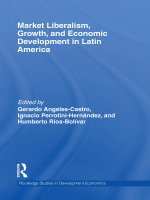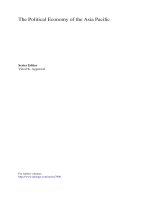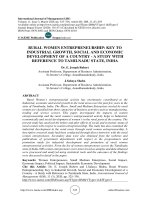Economic growth and economic development 372
Bạn đang xem bản rút gọn của tài liệu. Xem và tải ngay bản đầy đủ của tài liệu tại đây (89.78 KB, 1 trang )
Introduction to Modern Economic Growth
trajectory starting at i0 (0), k˙ (t) /k (t) > 0, and thus we have
d(q(t)k(t))/dt
q(t)
˙
≥
q(t)k(t)
q(t)
00
˙
(i(t))
i(t)φ
=
0
1 + φ (i(t))
= r + δ − f 0 (k(t))/(1 + φ0 (i(t))),
where the second line uses (7.60) and (7.61), while the third line substitutes from
(7.62). As k (t) → ∞, we have that f 0 (k (t)) → 0, implying that
lim exp (−rt) q (t) k (t) ≥ lim exp (−rt) exp ((r + δ) t) = lim exp (δt) > 0,
t→∞
t→∞
t→∞
violating the transversality condition. In contrast, if we start with i00 (0) < i (0) as
the initial level, i (t) would tend to 0 in finite time (as shown by the fact that the
trajectories hit the horizontal axis) and k (t) would also tend towards zero (though
not reaching it in finite time). After the time where i (t) = 0, we also have q (t) = 1
and thus q˙ (t) = 0 (from (7.60)). Moreover, by the Inada conditions, as k (t) → 0,
f 0 (k (t)) → ∞. Consequently, after i (t) reaches 0, the necessary condition q˙ (t)
= (r + δ) q (t)−f 0 (k (t)) is necessarily violated. This proves that the unique optimal
path involves investment starting at i (0).
We next turn to the “q-theory” aspects. James Tobin argued that the value of
an extra unit of capital to the firm divided by its replacement cost is a measure of
the “value of investment to the firm”. In particular, when this ratio is high, the firm
would like to invest more. In steady state, the firm will settle where this ratio is 1
or close to 1. In our formulation, the costate variable q (t) measures Tobin’s q. To
see this, let us denote the current (maximized) value of the firm when it starts with
a capital stock of k (t) by V (k (t)). The same arguments as above imply that
(7.65)
V 0 (k (t)) = q (t) ,
so that q (t) measures exactly by how much one dollar increase in capital will raise
the value of the firm.
In steady state, we have q˙ (t) = 0, so that q∗ = f 0 (k∗ ) / (r + δ), which is approximately equal to 1 when φ0 (δk∗ ) is small. Nevertheless, out of steady state,
q (t) can be significantly greater than this amount, signaling that there is need for
358









